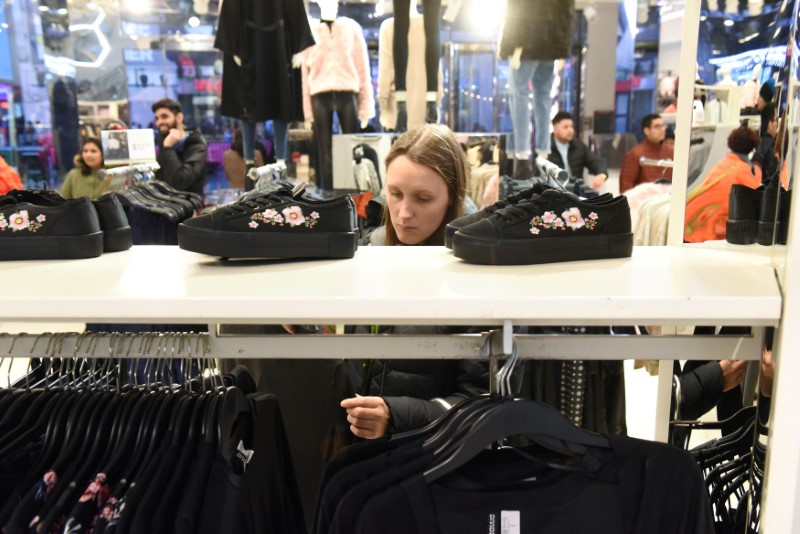By Lucia Mutikani
WASHINGTON (Reuters) - U.S. consumer prices increased in January, with a gauge of underlying inflation posting its largest gain in 12 months, bolstering views that price pressures will accelerate this year.
Those expectations were underscored by other data on Thursday showing the number of Americans filing for unemployment benefits fell last week to a 48-year low as the labor market tightens. Another a survey showed prices paid by manufacturers for raw materials hit a more than six-year high in February.
The combination of rising inflation and a robust labor market could force the Federal Reserve to raise interest rates a bit more aggressively this year than currently anticipated as it worries about the economy overheating. The U.S. central bank has forecast three rate hikes in 2018. The first rate increase is expected later this month.
"The Fed wanted to see more inflation and it looks like it is getting it," said Joel Naroff, chief economist at Naroff Economic Advisors in Holland, Pennsylvania. "I am down for four (rate hikes) because the acceleration in inflation is not likely to fade anytime soon."
The Commerce Department said consumer prices as measured by the personal consumption expenditures (PCE) price index rose 0.4 percent. That was the biggest increase since September and followed a 0.1 percent gain in December. The annual increase was, however, unchanged at 1.7 percent in January because of unfavorable base effects.
Excluding the volatile food and energy components, the PCE price index advanced 0.3 percent in January - the largest gain since January 2017. The so-called core PCE price index rose 0.2 percent in December. Base effects also kept the annual increase in the core PCE price index unchanged at 1.5 percent in January.
The inflation readings were in line with economists' expectations. The core PCE index is the Fed's preferred inflation measure and has undershot the central bank's 2 percent target since mid-2012.
Inflation is expected to rise toward its target this year also as a $1.5 trillion tax cut package and increased government spending spur faster economic growth. Rising commodity prices as well as a weakening U.S. dollar are also seen stoking inflation.
"All the ingredients are in place. We are going to see inflation perk up a little through the rest of this year, but there is no cause for concern," said Ryan Sweet, senior economist at Moody's Analytics in West Chester, Pennsylvania.
Fed Chairman Jerome Powell earlier this week offered an upbeat assessment of the economy, saying before the U.S. House of Representatives Financial Services Committee "my personal outlook for the economy has strengthened since December."
On Thursday, Powell told the Senate Banking Committee that there was no evidence of the economy overheating and also that "the thing we don't want to have happen is to get behind the curve."
The dollar initially firmed against a basket of currencies before surrendering gains to trade little changed. Prices for U.S. government bonds rose marginally while stocks on Wall Street fell.
CONSUMER SPENDING COOLS
In another report, the Institute for Supply Management (ISM) said its index of prices paid by factories increased to a reading of 74.2 in February, the highest level since May 2011, from 72.7 in January.
The ISM's overall index of national factory activity jumped to a reading of 60.8 last month from 59.1 in January amid strong order growth and hiring. A reading above 50 in the ISM index indicates growth in manufacturing, which accounts for about 12 percent of the U.S. economy.
January's increase in inflation cut into consumer spending growth. Consumer spending, which accounts for more than two-thirds of U.S. economic activity, gained 0.2 percent. That was the smallest increase since August and followed a 0.4 percent advance in December.
When adjusted for inflation, consumer spending fell 0.1 percent, declining for the first time in a year. The so-called real consumer spending rose 0.2 percent in December.
The drop in real consumer spending in January suggests consumption will slow this quarter from the fourth-quarter's robust 3.8 percent annualized growth pace.
It was also the latest indication that economic growth moderated at the start of the year after a 2.5 percent rate of expansion in the fourth quarter. Industrial production, home sales and core capital goods orders fell in January while construction spending was flat.
Growth estimates for the first quarter are as low as a 1.7 percent rate. But spending remains underpinned by a strong labor market. In a third report on Thursday, the Labor Department said initial claims for state unemployment benefits dropped 10,000 to a seasonally adjusted 210,000 for the week ended Feb. 24, the lowest level since December 1969.
Consumer spending could also get a lift from the tax cuts, which boosted income and savings in January. The Commerce Department's Bureau of Economic Analysis estimates that the tax package reduced personal income taxes by $115.5 billion at an annual rate.
Income at the disposal of households after taxes surged 0.9 percent in January, the biggest gain since December 2012, after rising 0.4 percent the prior month.
Wages were also boosted by one-off bonuses that businesses gave workers as part of the tax-cut windfall. The saving rate jumped to 3.2 percent from 2.5 percent in December.

"This will give consumers the necessary fire-power to ramp up their spending in the months ahead," said Scott Anderson, chief economist at Bank of the West in San Francisco.